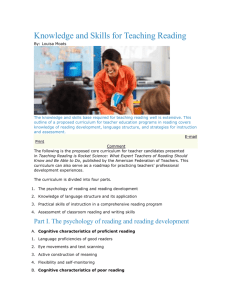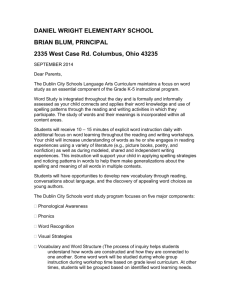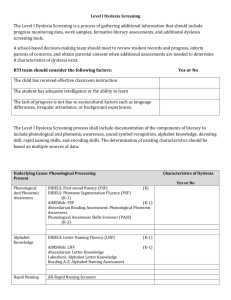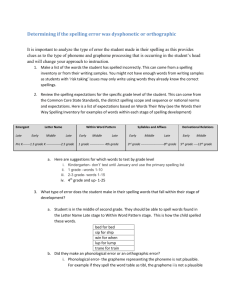Diagosing Learning Disabilities
advertisement
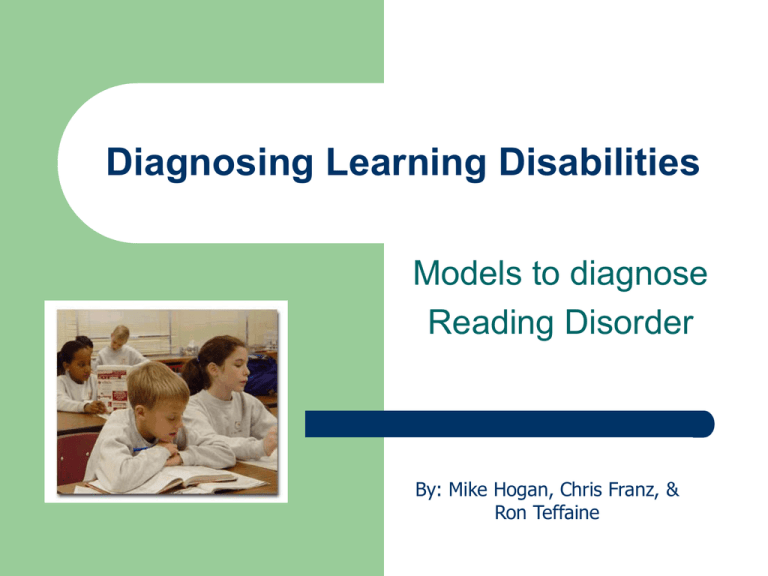
Diagnosing Learning Disabilities Models to diagnose Reading Disorder By: Mike Hogan, Chris Franz, & Ron Teffaine Canadian Definition of Learning Disabilities (January 30, 2002) Learning Disabilities (LDs)… affect… individuals… [with] at least average abilities… As such, LDs are distinct from global intellectual deficiency. LDs result from impairments in one or more processes related to perceiving, thinking, remembering or learning (e.g., language processing, phonological processing, processing speed, memory & attention, executive functions, etc.). LDs interfere with (1) oral language, (2) reading, (3) written language, and (4) mathematics. LDs are lifelong… [They] are suggested by unexpected academic under-achievement. LDs are due to genetic and/or neurobiological factors or injury that alters brain functioning… DSM-IV-TR LD Model (1994/2000) Learning Disorders are diagnosed when: – – an individual’s achievement in reading, mathematics, or written expression is substantially below that expected for age, schooling, and level of intelligence (e.g., ≥ 1½ SDs below the mean). the learning problems significantly interfere with academic achievement or activities of daily living that require reading, math, or writing skills. DSM-IV-TR LD Model Associated Features & Disorders: – – – – Abnormalities in cognitive processing (e.g., visual perception, linguistic processes, attention, memory, etc.) Medical conditions: lead poisoning, fetal alcohol syndrome, fragile X syndrome Demoralization, low self-esteem, social skills deficits, increased drop-out rate (1.5 times > average) Higher rate of Disruptive Behaviour & Mood Disorders DSM-IV-TR LD Model Differential Diagnosis – LDs must be differentiated from: Normal variations in achievement (< 1 SD below mean) Lack of opportunity (e.g., poor attendance) Poor teaching (e.g., home schooling) Cultural factors (e.g., EAL) Impaired vision or hearing Mental retardation (except Mild cases) DSM-IV-TR Reading Disorder Diagnostic Criteria: A. Reading achievement (via individually administered standardized tests of reading accuracy, speed, or comprehension), is substantially below that expected given the person’s age, measured intelligence, and ageappropriate education. B. The disturbance in Criterion A sig. interferes with achievement or activities of daily living that require reading. C. If a sensory deficit is present, the reading difficulties are in excess of those usually associated with it. Coding Note: If a general medical (e.g., neurological) condition or sensory deficit is present, code the condition of Axis III. Using the DSM-IV-TR Model Look for chronic underachievement in reading: – – – Interview teachers and parents at referral Observe student’s reading continuum, past running records, & results from informal reading inventories Check cumulative file for comments & lower marks in ELA, as well as failed progress in Reading Recovery and/or Early Literacy Intervention programs Look for family history of reading problems: – Use background questionnaire &/or interview parents Using the DSM-IV-TR Model Rule out competing explanations: – – – – – – Poor or inconsistent school attendance Possible EAL status History of home-schooling Vision and hearing problems CDC reports of global developmental delay &/or below average intellectual level previously found Little or no home support of literacy Using The DSM-IV-TR Model Conduct individual standardized testing: – – Aptitude tests (e.g., WISC-IV) Achievement tests (e.g., WIAT-II/GORT-IV or WIAT-III): – – Ensure you have tests of word reading, decoding or word attack, comprehension, and reading fluency A spelling test facilitates error analysis for sub-typing Do ability-achievement discrepancy analysis (predicted achievement > simple difference; sig. at p < .05; use a base rate of 10% or lower for severe LD) Include other processing tests that correlate with reading achievement (e.g., PAT, CTOPP, PAL-II – phonological awareness, orthographic awareness, rapid naming, morphological awareness, TOC, SIT, NEPSY-II, etc.) The Cross-Battery Model of LD (Flanagan, Ortiz, Alfonso & Mascolo, 2006) Four Level Approach: Level I-A, normative deficit in academic functioning Level I-B, exclusionary factors for academic deficit must be ruled out Level II-A, normative deficits in cognitive abilities/processes Level II-B, exclusionary factors are ruled out for cognitive deficits Level III, establish consistency between specific cognitive deficits and specific areas of academic underachievement and otherwise normal functioning in areas unrelated to academic deficits Level IV, evidence of functional limitations in daily activities related to the academic deficit CHC Consistency Approach to LD Diagnosis Gf: Inductive (I), and General Sequential Reasoning (RG) play a moderate role in reading comprehension Gc: Language Development (LD) and Lexical Knowledge (VL), and Listening Ability (LS) play an important role and become increasingly important as students age Gsm: Memory span is important especially within the context of working memory Ga: Phonetic Coding or phonological processing is very important during elementary school years Glr: Naming facility or rapid automatic naming is very important during elementary years Gs: Processing speed is important during all school years particularly during elementary Moderate correlation with reading Strong association with reading Interpreting Results Dyslexia Subtypes The universal “Dyslexia Signature” based on fMRI research by Dr. Sally Shaywitz, et al. 1998 & 2002 Dyslexic readers use compensatory systems to read Sally Shaywitz, Overcoming Dyslexia, 2003 Interpreting Results Phonological Dyslexia (~ 75%) – (Decoding < reading comprehension) < AVERAGE – Sight word recognition somewhat better than decoding Reading fluency is typically slow (this may persist even after remediation) Primary deficits in phonological awareness (e.g., segmentation, deletion, blending, and so on of syllables, phonemes, etc.) Often weak in auditory working memory and factual information Has trouble spelling phonetically regular words – – – – Interpreting Results Surface or Orthographic Dyslexia (~ 15%) – – – – – Primary deficit in orthographic processing Decoding better than sight word recognition Over-reliance on sound/symbol associations Try to sound out every word (e.g., sign = /sig-en/) Very slow and laborious reading speed Interpreting Results Mixed dyslexia (~10 %) – – – Involves reading/spelling features of both phonological and orthographic dyslexia Severely impaired in reading, and progress will be very slow Results in very bizarre error patterns & poor syllabic representation: e.g., Advice read as “Exvices” – e.g., Material read as “Mitear” – Rare Reading Disorder Subtypes Hyperlexia - uncanny ability to decode words despite significant cognitive deficiency. Comprehension very poor. This may be found among those with Autism Spectrum Disorder. Deep Dyslexia - a reading comprehension disorder characterized by impairments reading words with abstract meanings; but reading more concrete, easily imagined words are intact. DeJerine Syndrome - dyslexia without dysgraphia. Student has little difficulty writing, though cannot read. Two Reading Disorder Subtypes Proposed by Dr. Byron Rourke Phoneme-Grapheme Matching Disorder Word Finding Disorder Phoneme-Grapheme Matching Disorder Key Deficit: Phoneme-grapheme matching problems are paramount (most often noticed in difficulties in translating graphemes to phonemes) – Grapheme-to-Phoneme Conversion: Convert a written word (e.g., wharf) to its pronunciation or corresponding sound sequence (e.g., W OW R F) during oral reading task – Phoneme-Grapheme Conversion: Convert the sound sequence /W OW R F/ to a written form /wharf/ during spelling tasks PGMD Prognosis Written spelling of sight words are average Phonological awareness is normal Poor auditory/verbal memory Word decoding is poor, but not as severe as the phonological core LD group Matching printed to spoken words is poor Written spelling of words not known “by sight” is poor Writing letters and words to dictation is poor Outcomes are much better than the phonologically impaired LD group Word-Finding Disorder Word-finding and verbal-expressive skill deficits, within a context of a wide range of intact skills and abilities (e.g., average phonological awareness and phonemegrapheme matching skills) NOTE: The only major deficit is difficulty in accessing their normal store of verbal associations. WFD Prognosis Reading and spelling are very poor during the early school years. Near average or average performance in these areas emerging towards grade 6-to-8. Arithmetic and math reasoning seen as strengths. The PAL-II Model of Diagnosing Reading Disabilities Step 1 Has the child had insufficient opportunity to learn English? Does the child have MR, ASD, Language Disorder, or social emotional disorder Does the child have any known genetic disorders or brain injury or disease that affects brain function? Step 2 Step 2 1. Obtain a reliable measure of Verbal Comprehension/ Crystallized IQ - WISC-IV, WJ III, KABC-II, DAS-II, etc. 2. Assess the students: - Sight-Word Knowledge (WIAT-II Word Reading; WJ III Letter-Word Identification) - Reading Comprehension - Spelling - Word Attack (WIAT-II Pseudoword Decoding; WJ III Word Attack) - Reading Fluency (GORT-4; WJ III Reading Fluency) • VIQ > 91? (and) • Any reading or spelling test fall 15 points below the mean? Note: The size of the discrepancy may depend on the amount of specialized instruction Step 3 Assess the student’s phonological awareness, orthographic coding, rapid automatic naming (naming facility), and executive abilities (inhibition & switching) Reliable Tests for Step 3 Phonological Awareness •CTOPP •PAT-II •WJ III •PAL-II •NEPSY-II Rapid Automatic Naming •CTOPP •PAL-II RAN subtests •NEPSY-II Speeded Naming Orthographic Coding •PAL-II Receptive Coding •PAL-II Expressive Coding Executive Function •Inhibition/Self-Monitoring •D-KEFS Color-Word Interference •NEPSY-II Inhibition •NEPSY-II Auditory Attention •Switching Attention or Stimuli/ SelfMonitoring •NEPSY-II Letter/Number Naming •PAL-II RAS •NEPSY-II Inhibition •D-KEFS Verbal Fluency: Category Switching Case Study: Estelle 11½ yrs. Reason for Referral: Reading and spelling problems Test Battery: WJ III (7 core tests+ 2 optional tests) NEPSY Word Generation WIAT-II Word Reading, Reading Comprehension, & Spelling WJ III ACH Reading Fluency Writing Sample PAL-II – Phonological Coding (Syllables, Phonemes, & Rimes) – Morphological Coding & Decoding – RAN – RAS – Pseudoword Decoding – Orthographic Coding – Verbal Working Memory: Letters & Words Note: 25 individual subtests Estelle’s Assessment Results Cognitive Ability – – – – – – GIA/FSIQ= 101 Gc/VIQ= 96 Gf/Gv (PRI)= 109 Long Term Storage/Retrieval (Glr)= 110 Gsm=118 (Memory Span=109; Working Memory= 122) Gs= 78 (Speed of Reasoning=96; Visual Perceptual Speed= 67) READING/SPELLING ASSESSMENT: Core Tests: – – – – Word Reading= 85 Reading Fluency= 86 Reading Comprehension= 92 Spelling= 79 – Spells phonetically Errors on irregular words (e.g., kome for comb; juce for juice), some digraphs & blends (e.g., ph, gh), vce rules (kacke for cake), and r-controlled vowels. Writing= 75 Weak organization, grammar, idea generation, sequence of ideas, content, vocabulary Reading-Spelling Processes: – – Average Phonological Awareness (SS= 101) Average Naming Facility – Below Average Orthographic Awareness & Orthographic Working Memory – PAL-II Orthographic Processing Score= 70 NEPSY Word Generation (S & F words): below average PAL-II Verbal Working Memory= 80 Below Average Word Attack Skills (phonological – RAN= 90 PAL-II Pseudoword Decoding= 85 Executive Function (Switching Mental Sets) RAS= <85 Conclusions Surface Dyslexia Disorder of Written Expression Recommendations: – Remedial Strategies: – Barton Program (Level II) Precision Reading (fluency & sight word knowledge) Rosner Word Decoding Program (Decoding & Orthographic Awareness) Orthographic Awareness Activities (PAL-II) Adaptations Thank you Any questions?


